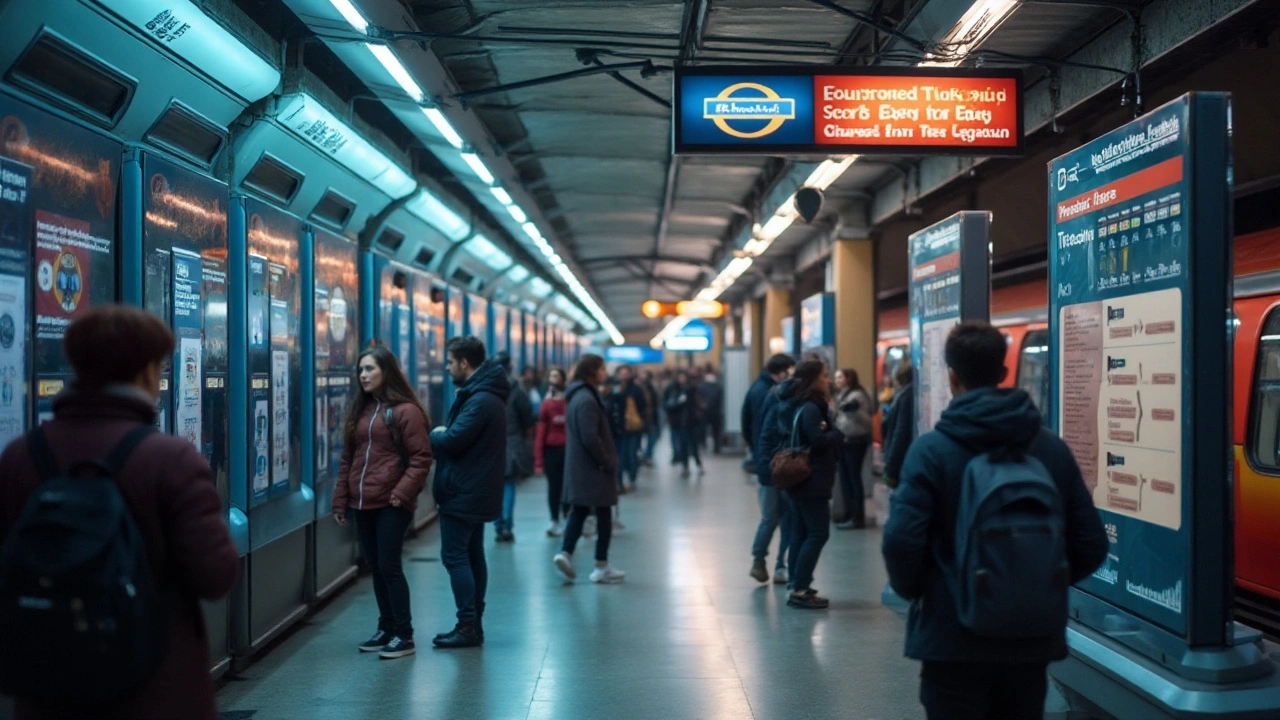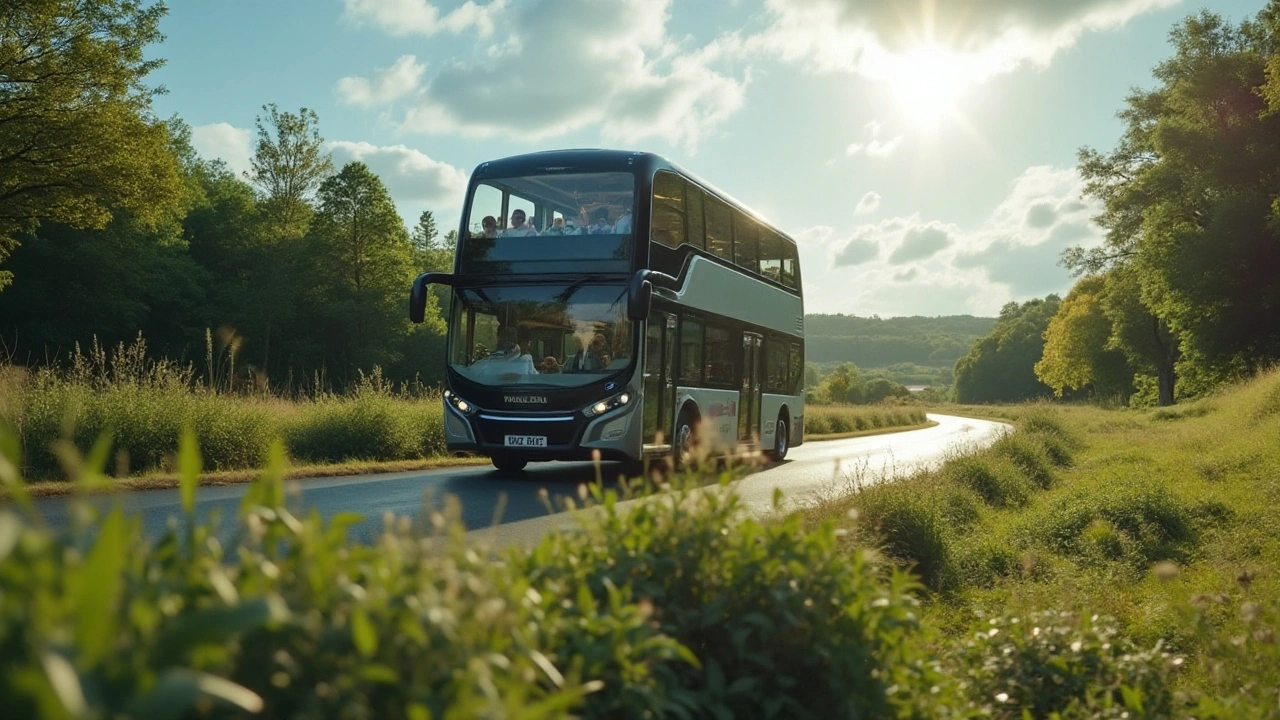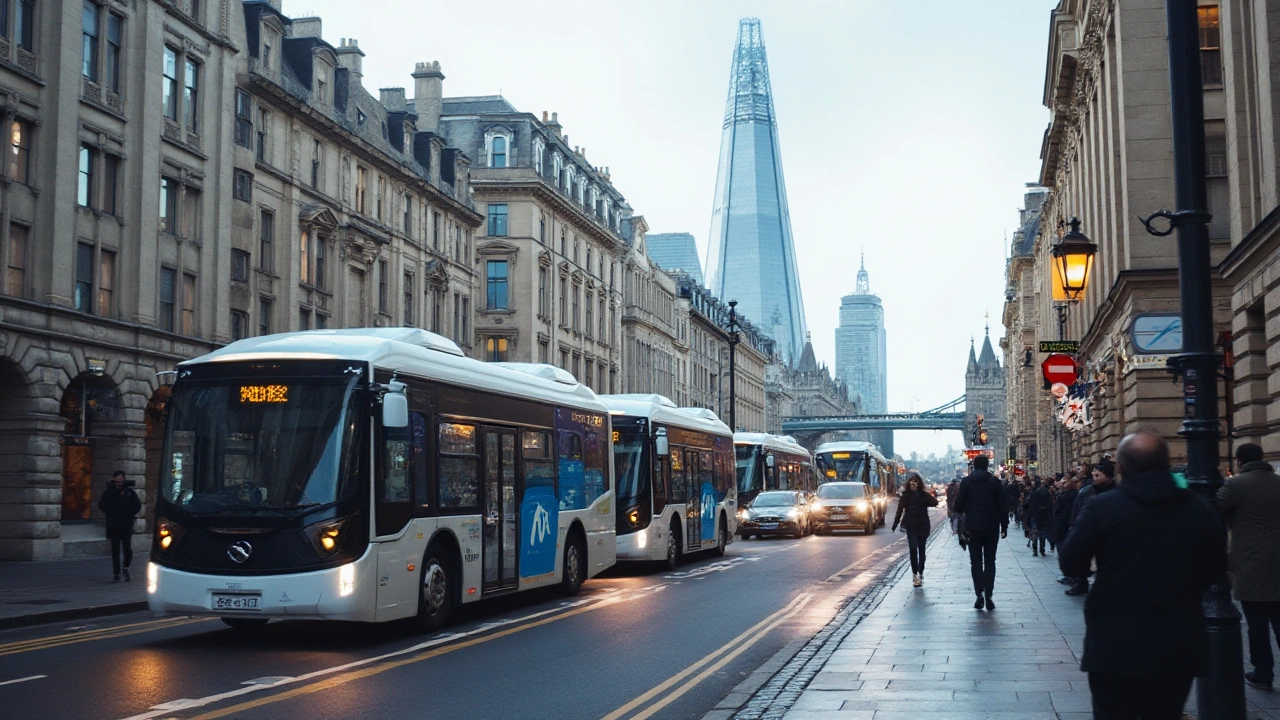Public transportation is the backbone of urban life, connecting people to jobs, education, and essential services. But as cities expand, the pressure on these systems mounts. Enter AI, a blend of cutting-edge technology and innovative problem-solving approaches, poised to transform the way we travel.
Imagine buses, trains, and trams running with clockwork precision, always on time, and effortlessly adapting to changing conditions. That's the promise of AI in public transport. From predictive maintenance to optimize fleet operations to real-time data analysis for improving passenger experiences, AI is unlocking a new era of smart transportation.
However, like any innovation, integrating AI comes with its own set of challenges, including privacy concerns and the need for significant infrastructure upgrades. Here, we explore how AI is already being employed to tackle some of these challenges and what the future holds.
- The Role of AI in Modern Transportation
- Enhancing Efficiency and Reducing Costs
- Improving Passenger Experience with AI
- Environmental Benefits of AI in Transportation
- Challenges and Concerns in AI Integration
- Future Prospects of AI in Public Transit
The Role of AI in Modern Transportation
Modern cities are bustling hubs of activity, where every second counts, and efficient public transportation is an absolute must. This is where AI comes into the picture, reshaping how we plan, use, and experience urban transit systems. At its core, AI provides valuable insights drawn from data, capturing trends and making predictions that give transport operators a clearer picture of what to expect. Imagine being able to predict traffic patterns based on various factors like time of day, weather, and even local events. Utilizing historical and real-time data, AI algorithms forecast these scenarios, allowing transportation systems to adjust schedules, reroute vehicles, or add additional service as needed. This proactive approach helps mitigate delays and provides a smoother, more reliable service.
One standout application of AI in public transport is predictive maintenance. By monitoring the health and performance of vehicles in real-time, AI systems can predict when a part is likely to fail, allowing for repairs to be made before an actual breakdown occurs. This helps to reduce unplanned downtime, which in return improves efficiency and saves money. For example, city buses and trains equipped with sensors can constantly relay information about engine health, brake systems, or air conditioners back to a centralized system. This information is processed by AI tools to detect anomalies that suggest impending failures.
"Data is the oil of the digital era, and AI is the combustion engine." - Peter Sondergaard, Senior Vice President, Gartner Research
Moreover, AI is changing the game in terms of enhancing passenger experiences. By analyzing passenger flow and feedback, transportation systems are better equipped to manage crowding and ensure safety. AI-driven applications can offer personalized travel suggestions, delay predictions, or alternative routes in real-time. This creates a more informative and stress-free travel experience for commuters. Consider a scenario where AI algorithms working behind the scenes alert passengers of train congestion, offering less crowded options, and ensuring a more comfortable ride.
Autonomous and AI-Assisted Vehicles
The development of self-driving or autonomous vehicles is one of the most thrilling branches of AI in public transit today. Though fully-automated systems are still being tested and refined, AI-assisted vehicles are becoming more prevalent, featuring in systems like driver-assist modes on buses and trams. The goal is safety; fewer accidents and more reliable transport schedules can be achieved with AI’s assistance. This technology uses a combination of sensors, cameras, and learning models to process an extensive amount of data on road conditions, obstacles, and other motorists' behaviors.
In places where AI-enhanced or autonomous public transport is active, cities are reporting noticeable reductions in traffic congestion and emissions. As these systems become more prominent, it will be fascinating to watch how they integrate with existing networks and how commuters adapt to sharing space with intelligent machines. Just imagine a future where everyday travelers feel like there’s always a personal touch to urban mobility, thanks to the silent yet powerful role of AI. It’s truly a step closer to realizing smart cities, where technology serves to ease the hustle and bustle of daily commute.
Enhancing Efficiency and Reducing Costs
When considering the modern demands on public transportation systems, two elements rise to the forefront: efficiency and cost-effectiveness. As urban populations swell and environmental concerns heighten, cities are under immense pressure to keep transit moving swiftly and economically. Enter AI, a beacon of innovation promising to streamline operations and cut expenses. But how exactly does this technology achieve such feats?
One of the primary ways AI enhances efficiency is through intelligent scheduling. By analyzing historical data and current traffic conditions, AI algorithms can predict and adjust schedules with uncanny precision. This adaptability means buses and trains run fewer empty miles, and passengers wait less, boosting overall satisfaction. For instance, predictive analytics helps transit authorities anticipate rush hour demand spikes, enabling them to deploy additional vehicles exactly when and where needed, thus minimizing congestion and maximizing productivity.
AI also plays a pivotal role in maintenance, significantly cutting the costs usually associated with unexpected breakdowns and repairs. Through the use of smart sensors, public transit agencies monitor the health of their fleets in real-time. These sensors send alerts when a component is on the brink of failure, allowing for timely interventions. This proactive approach not only slashes repair costs but also extends the lifespan of vehicles, resulting in fewer replacements and significant budget savings.
Energy management is another area where AI proves invaluable. Advanced systems can optimize routes and driving styles for buses to conserve fuel, thus reducing expenses and emissions. In some cities, electric buses use AI to determine optimal charging schedules and routes that minimize energy consumption, aligning with both fiscal and environmental goals. This aspect of AI not only makes transportation greener but also vastly more economical over time.
To illustrate, a report by the International Transport Forum in 2023 highlighted that cities adopting AI-driven smart traffic management systems realized a 30% reduction in operational costs within two years. The implementation of these systems demonstrates the shifting paradigm towards tech-savvy solutions that dovetail economic pragmatism with ecological stewardship. A public transport official remarked, "AI doesn’t just make systems smarter; it makes the impossible, possible."
Smart cities around the world are swiftly incorporating AI into their transit strategies, and for good reason. The initial investment in AI infrastructure might be significant, but the returns, as shown in numerous case studies, yield dividends far exceeding initial expectations. This grants cities the financial flexibility to reinvest in other vital sectors, further advancing public welfare. With these advancements, public transportation might not just meet demands— it will exceed them, setting new standards for what sustainable and efficient transport can achieve.

Improving Passenger Experience with AI
Public transportation has always been about more than just getting from point A to point B. It's an essential part of daily life, and the experience during those journeys can have a significant impact on how passengers feel about their day. AI is stepping in to make public transportation not just more efficient, but more enjoyable and seamless. By integrating advanced technologies, public transport systems can offer personalized and dynamic services suited to each commuter's needs.
With the advent of AI, we see the creation of smarter and more responsive transportation networks. Machine learning algorithms analyze vast amounts of data in real-time, from traffic conditions and weather patterns to passenger loads and schedule deviations. This information is sometimes shared with passengers through apps or digital displays, allowing them to make informed decisions. For instance, AI can predict the arrival of the next bus or train with incredible accuracy, helping passengers to plan their journeys more effectively.
Mass transit systems are also taking cues from e-commerce platforms by leveraging AI for personalized service recommendations. Using data analysis, AI-driven systems can suggest optimal routes based on a passenger's past behavior, preferences, or even the current state of traffic. It's a shift from a one-size-fits-all approach to a tailored experience, putting the commuter at the center of the transit ecosystem. In a study conducted by the Massachusetts Institute of Technology, it was noted that personalized travel advice improved commuter satisfaction by as much as 20%.
AI-Driven Accessibility and Inclusivity
Artificial intelligence is also paving the way to more inclusive transport solutions. Features like voice recognition and facial recognition can assist passengers with disabilities, allowing for a more independent travel experience. AI can alert personnel at the next station of the arrival of someone who might need assistance, enhancing service delivery for all users. This technology ensures that public transportation is accessible not just for the majority, but for every individual.One of the most thrilling advancements is in multilingual support, where AI offers on-the-go translations, breaking down language barriers for international passengers or those uncomfortable with the local language. This feature can transform what could be an intimidating journey into a welcoming and enriching experience. As stated by a spokesperson of Transport for London, 'We're using technology to ensure every passenger feels their needs are recognized and addressed, integrating AI in ways that make a tangible difference in everyday journeys.'
Real-Time Insights and Feedback
Feedback loops powered by AI mean that passenger experiences are constantly being improved based on real-time data. Happier travel experiences are not only about efficient logistics but about comfort and convenience. Wi-Fi enabled buses and trains, AI-assisted cleaning schedules that adjust based on usage, and the automatic adjustment of heating and cooling systems based on crowding levels are just a few examples of how AI refines the experience.By continuously gathering passenger feedback through apps or digital kiosks, transport authorities can quickly implement changes that reflect real passenger needs. AI analyzes this data to spot trends and potential issues, which in turn helps transit authorities plan better and make necessary adjustments swiftly. It’s a mutually beneficial loop—passengers get a better experience, and the transport system becomes more efficient and effective. Such integration of AI truly makes for a smarter, more resilient public transportation system.
Environmental Benefits of AI in Transportation
Public transportation has long been a critical component of urban life, offering an alternative to personal vehicles and helping reduce congestion and pollution. As global cities grapple with the impacts of climate change, the application of AI in these systems becomes a game-changer for environmental sustainability. AI technologies can significantly decrease carbon footprints by predicting and adjusting to passenger flow, optimizing routes, and ensuring smoother operations without excessive fuel consumption. These technologies can help cut down energy use and reduce emissions, making public transport greener and cleaner.
One striking advantage of AI lies in its ability to analyze vast streams of real-time data to enhance efficiency and operational effectiveness. By understanding traffic patterns, weather conditions, and even events like concerts or sports games, AI can dynamically adjust routes and schedules to reduce travel time and avoid unnecessary idling of buses or trains. This can notably minimize fuel usage. For instance, machine learning algorithms monitor and predict peak periods, suggesting off-peak travel times or redirecting vehicles to less congested paths, thus curbing emissions and easing urban smog.
AI also plays a pivotal role in managing and maintaining infrastructure. Predictive maintenance uses sensors to anticipate engine failures or track wear and tear, allowing for timely repairs and reducing unexpected breakdowns that may cause jams or detours. Avoidances like these further reduce the unnecessary release of pollutants into the air. Moreover, the implementation of autonomous vehicles in public transport could offer a substantial leap. Driverless buses powered by renewable energies are already being tested in places like Singapore, demonstrating impressive efficiency and environmental consciousness.
"By harnessing AI, cities can create an intelligent transport network that positively affects the ecology," said Eloise Pascal from Urban Mobility Innovations.
Beyond reducing emissions, there are significant benefits to be reaped from AI-enabled ticketing and fare systems. Streamlined operations not only improve user experience but can also lower costs associated with manual ticketing processes. As AI makes services more seamless and appealing, the hope is to attract more public transport users, further decreasing the reliance on private vehicles and the environmental toll they take. Successfully transitioning to these strategies presents a substantial opportunity to build a sustainable future.
Success Stories and Statistics
Cities like Los Angeles and Copenhagen have increasingly integrated AI in their green transport initiatives. LA, for instance, has reduced bus idle time by approximately 15% since implementing AI technology, directly translating to lower fuel consumption. Copenhagen's AI-driven metro system has achieved significant gains in energy efficiency, claiming to consume 30% less power per passenger compared to traditional systems. These examples illustrate that AI in public transport isn't just a concept for tomorrow, but a viable and impactful solution for today's environmental challenges.

Challenges and Concerns in AI Integration
As the world races towards harnessing the power of AI in public transportation, there are several bumps on the road that mustn't be overlooked. One major concern lies in the privacy of passengers. With AI systems often relying on vast amounts of data to function effectively, there is an inevitable risk of breaching personal privacy. Public transport operators, as well as tech firms, must ensure that data collection and processing are done transparently and ethically. Without the right safeguards, sensitive passenger information could fall into the wrong hands, leading to breaches and possibly even identity theft.
Another key issue is the reliability of these AI systems. While AI can provide real-time insights and predict challenges before they arise, it is crucial that these systems are monitored and maintained meticulously. Technological glitches or failures could lead to delays and disruptions, proving that over-reliance on technology can sometimes backfire. Moreover, integrating AI into transport infrastructure requires massive financial outlay, which can be a significant hurdle for many cities, especially those in developing regions.
There is also the fear of job displacement. As AI takes over tasks traditionally performed by humans, such as scheduling and vehicle operation, many worry that this could lead to significant job losses in these sectors. While AI can indeed improve efficiency, it is essential that workers displaced by AI technologies be retrained for new roles within these evolving systems. A balanced approach that blends human skills with AI capabilities can yield the best outcomes. As noted by a renowned urban planner, "Technology should enhance human potential, not replace it."
Lastly, there are legislative challenges. The rapid evolution of AI technology often outpaces the development of regulations needed to govern it. Cities must work closely with technology providers and policymakers to establish clear guidelines on the ethical use of AI in public transportation. Such regulations should also address potential liabilities in case of accidents or mishaps involving AI-operated vehicles, ensuring the safety and trust of the public is maintained at all times. As we tread this new path, resolving these challenges responsibly will be pivotal to creating a future where public transportation is both intelligent and inclusive.
Future Prospects of AI in Public Transit
The future of public transportation looks incredibly promising with the integration of AI technologies. As urban areas continue to grow, the demand for efficient and reliable transit systems rises significantly. AI is not just a buzzword in this arena; it offers tangible solutions for real world challenges. One area where AI is set to make waves is in route optimization. By analyzing patterns from millions of trips, AI can suggest more efficient routes, minimizing delays and reducing fuel consumption, which not only saves money but also decreases environmental impact.
Another prospect lies in autonomous vehicles. While we're still some years away from fully driverless public transit systems, the groundwork is being laid today. Current testing in several cities around the globe demonstrates that autonomous buses and shuttles can operate safely and efficiently on pre-defined routes. Eventually, these systems could expand to cover more complex networks in larger cities. With self-driving technology, AI promises fewer accidents and consistent service without the limitations of human drivers' shifts.
Passenger experience is also set to transform. Imagine a world where public transportation is completely tailored to an individual's preferences and needs. AI can provide personalized recommendations for travel and alert systems that inform passengers about delays or problems in real time. An increase in safety can be expected too, with AI monitoring systems detecting any unusual activity or potential threats instantly. "The promise of AI is not just in its ability to handle data but in its potential to transform human experience by making urban commuting seamless," says Dr. Maria Loren, a transportation technology researcher.
However, the shift towards an AI-driven public transport network is not without its hurdles. Privacy concerns about the data being collected cannot be overlooked, and strategies to safeguard user information must be put in place. The initial cost of implementing AI technologies can be a barrier, although many cities are finding that the long-term savings are worth the upfront investment. Moreover, education and training for transit authorities and personnel will be vital in adapting these technologies successfully. For a comprehensive transformation to occur, cross-sector collaborations between tech companies, city planners, and government bodies are essential. This cooperation can ensure that AI implementation in public transportation is both effective and equitable.
Looking ahead, we can foresee a future where AI not only helps manage transit logistics behind the scenes but also directly enhances the commuter experience. While challenges exist, the technological advancements driven by AI in public transit offer opportunities that were unimaginable just a decade ago. As smart cities become increasingly common, AI stands at the forefront of the transformation, ready to revolutionize how we move through urban landscapes, making commutes more sustainable, efficient, and enjoyable for everyone.

